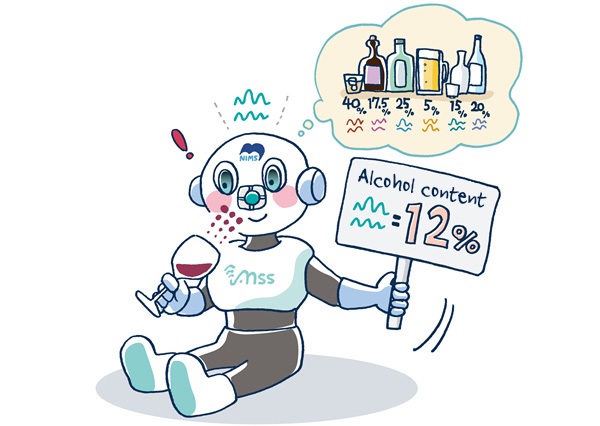- ホーム
- > 研究活動
- > Research Highlights
- > Vol. 38 Quantifying Smell with Nanopar・・・
 Research Highlights
Research Highlights
[Vol. 38]
Quantifying Smell with Nanoparticles-functionalized Membrane-type Surface Stress Sensor and “Data-driven” Analysis

Figure: An illustration of the present quantification of alcohol content by the data-driven nanomechanical sensing approach.
Chromatography is widely used for the quantitative identification of specific components in mixtures of compounds. For example, quantifying smell requires analysis of a complex mixture composed of thousands of chemical compounds. Although chromatography systems can be used to do so, the equipment is usually bulky and measurement procedures necessitate the time-consuming process to separate all the components into single species.
Here, Shiba, Tamura, Imamura and Yoshikawa at the International Center for Materials Nanoarchitectonics (MANA), Tsukuba, Japan, report on combining their invention, the Membrane-type Surface stress Sensor (MSS), functionalized nanoparticles, and “data-driven” analysis to quantitatively determine the concentration of alcohol from smell data contained in liquors with varying alcohol content.
Specifically, the surface of the MSS array was covered with four types of silica/titania functional nanoparticles that adsorb different target molecules in the test samples, and patterns of electrical signals were recorded.
Next, machine learning was used to analyze the massive amounts of data obtained from the electrical signal patterns to establish a prediction model for quantifying alcohol concentration of the smell sample.
Notably, materials more suitable for alcohol smells were selected based on machine learning results, and thereby the accuracy of prediction was improved.
“The importance of this research is not the fact that we determined the alcohol concentration, but that this approach enables the quantification of many other arbitrary indices,” says Shiba. “These findings have paved the way for applications for quantitative evaluation of natural products, which we have demonstrated in collaboration with universities and industry.”
Reference
“Data-driven nanomechanical sensing: specific information extraction from a complex system”
Kota Shiba, Ryo Tamura, Gaku Imamura, and Genki Yoshikawa
Journal : Scientific Reports, 7: 3661 (2017).
DOI : 10.1038/s41598-017-03875-7
Kota Shiba, Ryo Tamura, Gaku Imamura, and Genki Yoshikawa
Journal : Scientific Reports, 7: 3661 (2017).
DOI : 10.1038/s41598-017-03875-7
Affiliations
International Center for Materials Nanoarchitectonics (WPI-MANA), National Institute for Materials Science (NIMS), Namiki 1-1, Tsukuba, Ibaraki 305-0044, Japan
Contact information
ナノアーキテクトニクス材料研究センター (MANA)
〒305-0044 茨城県つくば市並木1-1
TEL: 029-860-4710
E-mail: mana-pr=ml.nims.go.jp([ = ] → [ @ ] )
TEL: 029-860-4710
E-mail: mana-pr=ml.nims.go.jp([ = ] → [ @ ] )

